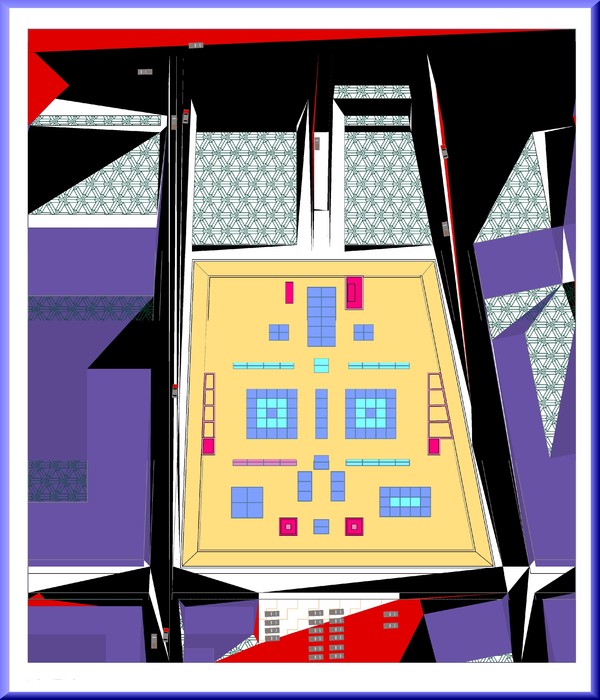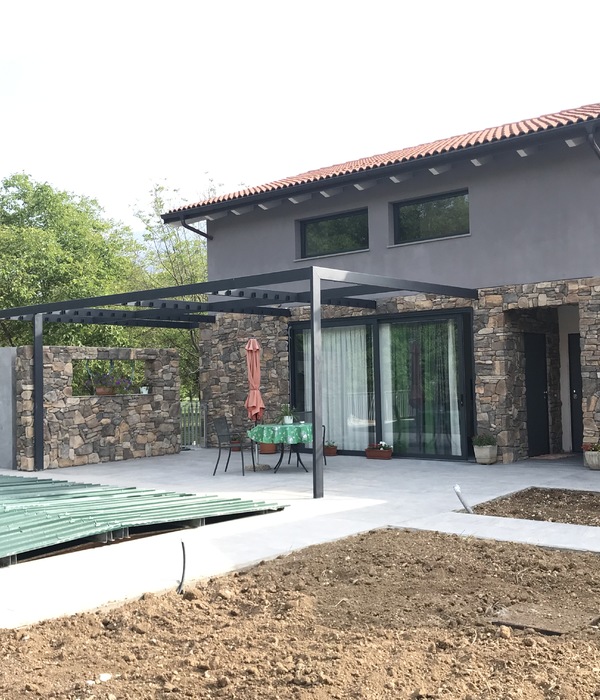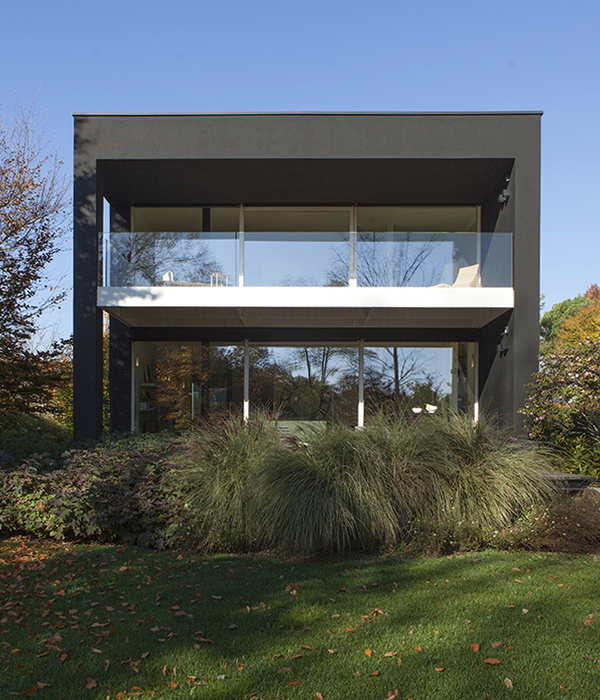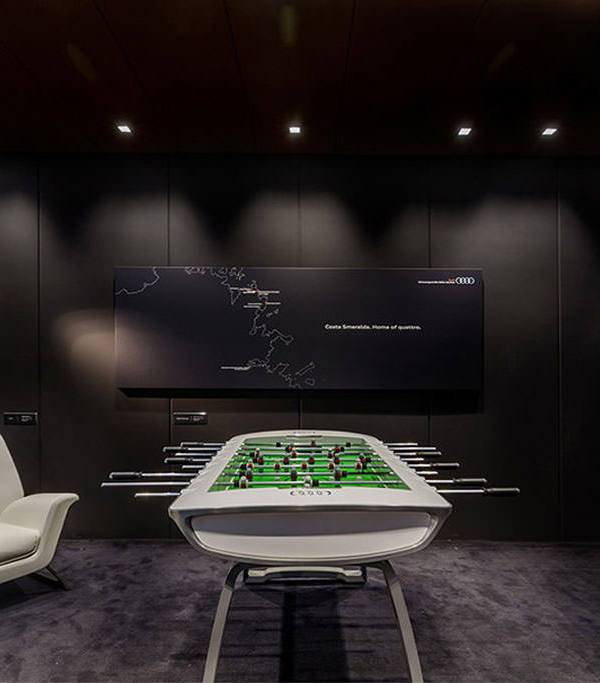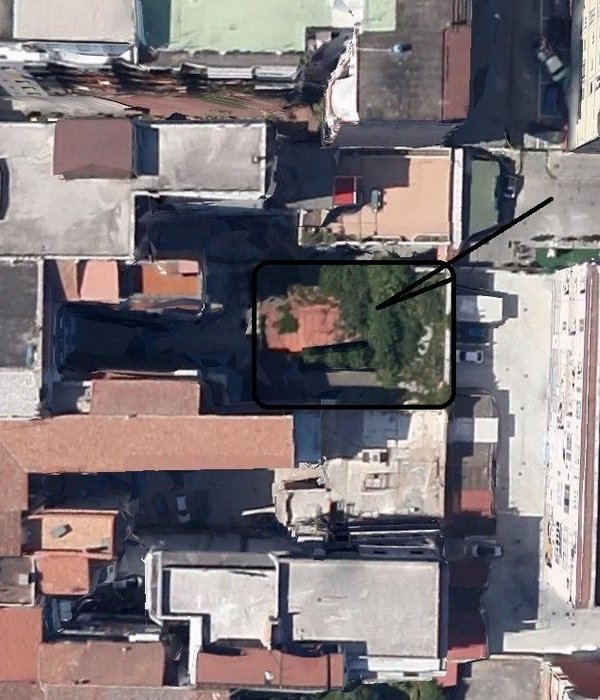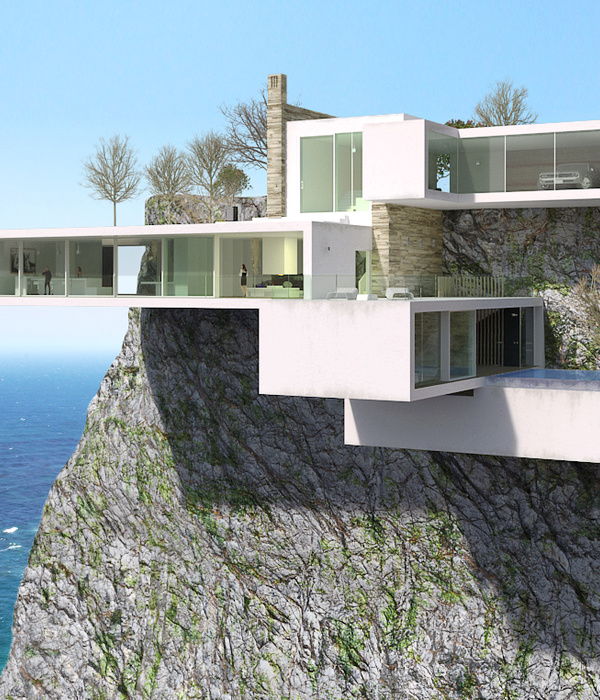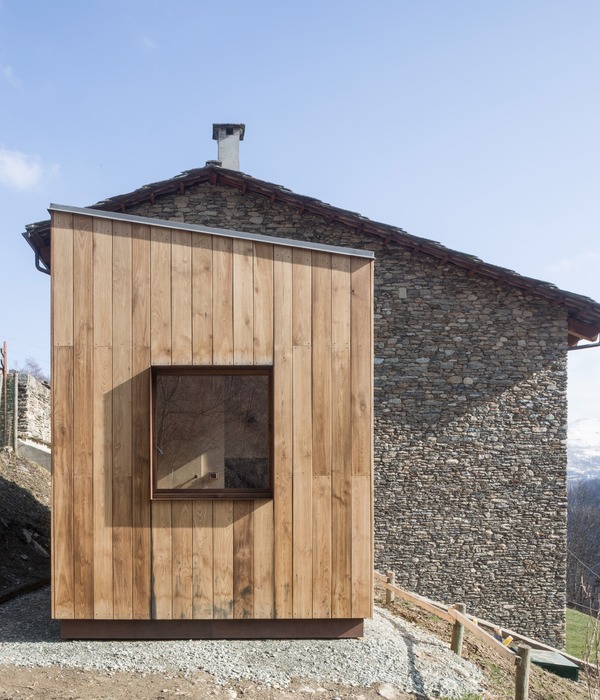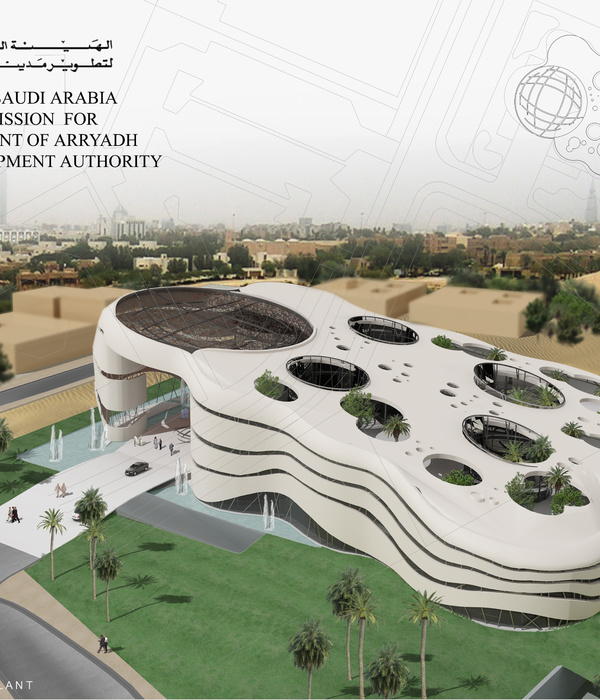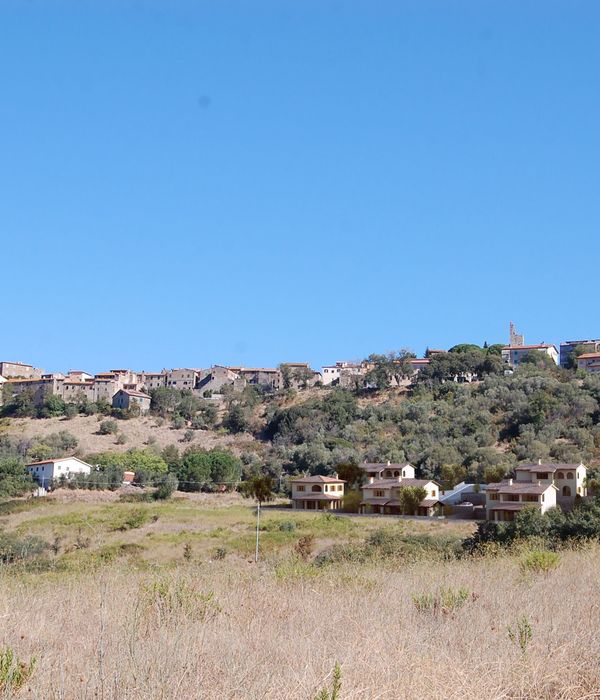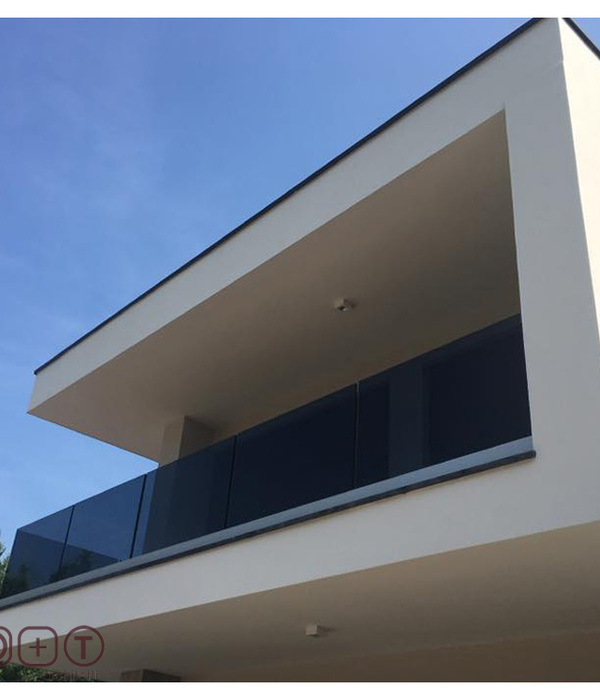桥宅坐落于西班牙米诺卡岛东北岸的Coves Noves住宅区。2400平方米的开阔场地使住宅得以尽可能地在水平方向上延伸,以捕捉周围最佳的风景。与此同时,住宅扭转的体量创造出令人惊喜的室内空间,并且获得了充满变化的外观。
Bridge House is located in Coves Noves, a residential area in the north-east coast of Minorca island, Spain. Its generous plot of 2400sqm allows the dwelling to stretch horizontally to capture the surrounding’s best landscape views. At the same time, its rotating volumes create surprising interior spaces and never repeating outlooks.
▼住宅外观,exterior view ©Adriâ Goulá
一系列小型体块基于正方形和五边形组合而成的平面相互堆叠,以轻盈的姿态悬浮在景观上空。桥梁般的组合方式为房子赋予了“桥宅”的称号。房屋的功能空间被划分为多个小尺度的单元,以便更精确地融入宽阔的场地。户外露台和泳池直接在室内平面的基础上延伸并与之保持了相同的几何形状,使绝大部分场地可以不受影响。
▼房屋的功能空间被划分为多个小尺度的单元,breaking down the program into smaller units seemed a more respectful way to place a large program onto the site ©Adriâ Goulá
Based on the assembly of squared and pentagonal plans, these small polyhydric volumes stack and hover over the existing landscape with playful lightness. Their bridge-like composition gives the house its name. Breaking down the program into smaller units seemed a more respectful way to place a large program onto the site. The outer terraces and pool are designed as a direct extension of the indoor plan, following its same geometries and keeping the vast majority of the plot untouched.
▼建筑鸟瞰&概览,aerial view & overview ©Nomo Studio
该住宅最初便被构想为一座度假屋,以供主人在这里享受温暖且充满户外气息的假期生活。因此,悬空的主体下方设置了近100平方米的超大门廊空间,成为整个住宅的“心脏”,可以用于大型的活动和聚会。游泳池和花园附近设置了户外厨房,拥有朝向前方大海和后方森林的双向视野。第二个门廊位于住宅的二层,与主厨房相连,更加方便日常的使用。该空间不仅拥有双向视野,还阻挡了来自相邻住宅区的视线。
▼从泳池望向门廊,view to the porch from the pool area ©Adriâ Goulá
▼近100平方米的超大门廊空间成为整个住宅的“心脏”,the very large porch of almost 100㎡ is conceived as the heart of the house ©Adriâ Goulá
This house has been thought primarily as a holiday house in Spain, where one spends most of the time outdoors enjoying the warm weather. Therefore, the very large porch of almost 100sqm, located under the hovering volumes, is conceived as the heart of the house, where large social gatherings take place. With the proximity of the pool and garden, and equipped with an outdoor kitchenette, one can enjoy the views in both directions, the sea to the front side, the forest to the back. A second porch on the first floor, in connection to the main kitchen, is meant for a more casual daily use. This space is also protected from neighbouring views and open to both sea and mountain views.
▼露台和立面细部,detailed view of the terrace and the facade ©Adriâ Goulá
住宅中包含相互连接的客厅和餐厅,以及5间卧室,其中一间是独立于建筑主体的客人卧室。公共空间从视觉上看是相互独立的,实际上则通过开放的入口形成流畅的连接。位于二层的主卧室连接至客厅和厨房,形成类似于公寓的居住体验。其余卧室均位于首层,与花园和泳池直接连通。浴室空间开放且明亮,拥有宽阔的落地窗户。此外还有一个独立的体量用于容纳车库、一间带露台(可晾晒衣物)的洗衣房,以及一个空间充裕的储藏室和设备间。
▼一层平面图,ground floor plan ©Nomo Studio
The program consists of an interconnected living and dining space and 5 bedrooms, one of them located independently as a guest pavilion. Common spaces are visually independent, however completely interlinked through open thresholds that create fluid circulations. The master bedroom on the first floor is connected with the living room and kitchen, thus functions as an apartment within the house. All other bedrooms are placed on the ground floor in direct connection to the garden and the pool. The bathrooms have been designed as open and bright spaces, with large floor-to-ceiling windows. Finally, a detached volume houses a garage, a laundry-room with a patio for hanging clothes and a large storage and installation room.
▼首层休闲空间,seating area on the ground floor ©Adriâ Goulá
▼二层厨房,kitchen on the first floor ©Adriâ Goulá
全白的立面回应了米诺卡岛传统建筑中常见的白色粉刷墙壁和覆盖以白色饰面的斜屋顶。基于这样的当地风格,桥屋采用了自清洗的连续白色灰泥饰面。嵌入屋顶板的隐蔽水槽可以保证外墙的清洁和维护能力。
Bridge House’s all-white facade responds to Minorca’s historical tradition of white-washed walls and pitch-roofs in a continuous white veil. Following this local custom, we chose a continuous self-washable white plastered finishing for walls, roofs and soffits. Concealed gutters where carved out from the roofs planes in order to guarantee good maintenance of the facade.
▼全白的立面呼应了米诺卡岛的传统,Bridge House’s all-white facade responds to Minorca’s historical tradition ©Adriâ Goulá
建筑外墙环绕着一圈2.1米高的、由白色穿孔铝板构成的滑动遮阳系统,为所有的窗户提供荫蔽。这些遮阳板一方面可以在抵挡阳光的同时保证视野不受阻碍,另一方面也提供了隐私性和安全性:从外部看,遮阳板呈现出封闭的观感,使外界无法望向室内。在房屋的背部,这些遮阳板被两种具有不同粗糙度的灰泥饰面所取代。在遮阳板关闭时,建筑呈现为一个纯白的几何体块,与蓝天形成鲜明对比。
▼外墙环绕着白色穿孔铝板构成的滑动遮阳系统,a horizontal stripe surrounds the house with an outer skin of white aluminium perforated sliding shutters ©Adriâ Goulá
A horizontal stripe of 210cm height surrounds the house with an outer skin of white aluminium perforated sliding shutters. Along these stripes are located all the windows of the building. These shutters have a double function: on one hand, they protect from direct solar radiation without blocking the views from the inside. On the other hand, they give privacy and security, since seen from the outside, their mesh becomes opaque and they allow the house to be completely locked down. On the back side, where there are no openings, the shutters disappear; however, these stripes continue as two different facade roughnesses: a softer and a rougher grain for the plastered finishing. When the shutters are closed, the strong geometric volumes stand out as pure white shapes against the blue sky.
▼遮阳板关闭时,纯白的几何体块与蓝天形成鲜明对比,when the shutters are closed, the strong geometric volumes stand out as pure white shapes against the blue sky ©Adriâ Goulá
挡土墙、楼梯和露台等景观元素采用了裸露的混凝土,避免与白色的多面体混为一体。建筑还采用了数种被动式的设计策略,以保证最高的A级能效水平,包括连续且厚实的外部隔热层、灵活的穿孔板遮阳系统、大尺度门廊、便于降温的高天花板以及低辐射玻璃等。
The landscape elements, such as retaining walls, stairs and terraces were kept in exposed concrete to avoid blending into the white polyhedrons. Several passive strategies were followed to guarantee the highest A-class energy efficiency level. A thick continuous outer insulation, flexible solar protection through sliding perforated shutters, large porches, high ceilings for cooling and low-emissive glass, amongst others.
▼庭院景观,courtyard landscape ©Adriâ Goulá
▼景观元素采用了裸露的混凝土,避免与白色的多面体混为一体,the landscape elements were kept in exposed concrete to avoid blending into the white polyhedrons ©Adriâ Goulá
室内空间所选用的材料与建筑全白的外观形成了强烈的对比。顶层的倾斜天花板被漆成淡绿色,使4米高的空间更显通透。浅色的桦木被用于衣柜、门框以及厨房的壁橱,标示出场景的变化,同时也使每个楼层获得了视觉上的统一。铺地材料选用了现场浇筑的粗糙水磨石,不含任何树脂添加剂,仅通过抛光混凝土直至露出颗粒。低矮的白色铝制底座形成了一个嵌入的缝隙,混凝土会从其下方流动,起到保护内墙的作用。白色大理石被用于浴室和厨房的台面,淋浴间的墙壁采用了绿色填缝的10×10哑光瓷砖。
▼浅色的桦木材料标示出场景的变化,light birch wood was used to mark the different inclinations ©Adriâ Goulá
▼天花板被漆成淡绿色,roof ceilings were painted in pastel green ©Adriâ Goulá
In contrast to the all-white abstract materiality of the facade, the choice of materials for the interiors was on purpose rather varied. Pitched roof ceilings were painted in pastel green to highlight the feeling of airiness of the 4m high spaces. Light birch wood was used in wardrobes, deep thresholds and kitchen closets to mark the different inclinations, always keeping a uniform finishing for each plane. The pavement is an in-situ casted rough terrazzo, made with no resin additives but by only polish a standard concrete until the grain is exposed. To protect the interior walls, a low white aluminium base creates a recessed slit, so that the concrete flows under it. White marble was used for bathroom and kitchen countertops and white mat 10×10 tiles with green joints in the shower walls.
▼衣橱,wardrobes ©Adriâ Goulá
▼浴室,bathroom ©Adriâ Goulá
照明系统根据整体设计量身定制。除了浴室之外,所有的房间均使用了间接照明。隐藏在垂直墙壁上方的LED灯带照亮了倾斜的绿色天花板,突出了空间的高度。楼梯、衣柜和厨房也通过隐藏的LED灯带照亮。所有的灯具都不直接暴露在墙壁或天花板上,这种做法为房间营造出了柔和的氛围,同时让高天花板和落地灯成为空间中的亮点。呼应住宅在外观上的低调姿态,内部空间也仅在需要时才进行照明,只有主入口通过嵌于地板的洗墙灯和造型独特的橄榄树被强调出来。
▼楼梯通过隐藏的LED灯带照亮,stairs are lit up through concealed LED stripes ©Adriâ Goulá
The thoroughly customized illuminations were very relevant to the overall design. Only indirect light is used all around the house, except for the bathrooms. In this way, LED stripes hidden above the vertical walls brighten up the inclined green ceilings highlighting the generous clear height of the rooms. Stairs, wardrobes and kitchen are also lit up through concealed LED stripes. The decision of avoiding both wall and ceiling exposed fixtures, creates a soft atmosphere and gives protagonism to the high ceiling and the standing lamps. From the outside, the villa aims to keep a low-profile and is therefore illuminated only where required. Only the main access, is emphasized through wall-washing floor lights and a sculptural olive tree.
▼住宅夜景,exterior view by night ©Adriâ Goulá
▼夜间立面局部,facade partial view by night ©Adriâ Goulá
▼场地平面图,site plan ©Nomo Studio
▼一层平面图,ground floor plan ©Nomo Studio
▼二层平面图,first floor plan ©Nomo Studio
▼屋顶平面图,roof plan ©Nomo Studio
▼立面图,elevations ©Nomo Studio
▼剖面图,sections ©Nomo Studio
Project: Single Family House Type: Commission Client: Private Collaborators: Structure – BIS Structures – Juan Mora SA Size: 360 m2 Location: Minorca, Spain Partner-in-Charge: Alicia Casals Project Leader: Alicia Casals Team: Karl Johan Nyqvist, Laura Guitart Noelia de la Red, Mario García, Marina Miró, Jordi Sarda, Maria Andanova Photography: Adriâ Goulá
{{item.text_origin}}

